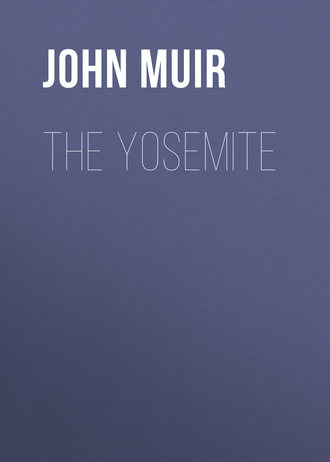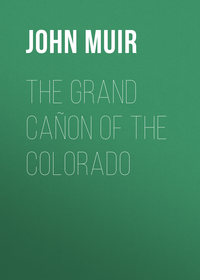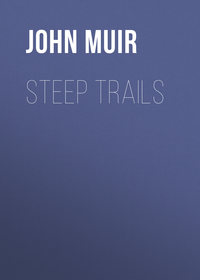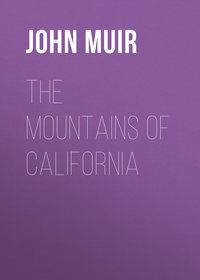 полная версия
полная версияThe Yosemite
The Yosemite Fall is separated into an upper and a lower fall with a series of falls and cascades between them, but when viewed in front from the bottom of the Valley they all appear as one.
So grandly does this magnificent fall display itself from the floor of the Valley, few visitors take the trouble to climb the walls to gain nearer views, unable to realize how vastly more impressive it is near by than at a distance of one or two miles.
A Wonderful Ascent
The views developed in a walk up the zigzags of the trail leading to the foot of the Upper Fall are about as varied and impressive as those displayed along the favorite Glacier Point Trail. One rises as if on wings. The groves, meadows, fern-flats and reaches of the river gain new interest, as if never seen before; all the views changing in a most striking manner as we go higher from point to point. The foreground also changes every few rods in the most surprising manner, although the earthquake talus and the level bench on the face of the wall over which the trail passes seem monotonous and commonplace as seen from the bottom of the Valley. Up we climb with glad exhilaration, through shaggy fringes of laurel, ceanothus, glossy-leaved manzanita and live-oak, from shadow to shadow across bars and patches of sunshine, the leafy openings making charming frames for the Valley pictures beheld through gem, and for the glimpses of the high peaks that appear in the distance. The higher we go the farther we seem to be from the summit of the vast granite wall. Here we pass a projecting buttress hose grooved and rounded surface tells a plain story of the time when the Valley, now filled with sunshine, was filled with ice, when the grand old Yosemite Glacier, flowing river-like from its distant fountains, swept through it, crushing, grinding, wearing its way ever deeper, developing and fashioning these sublime rocks. Again we cross a white, battered gully, the pathway of rock avalanches or snow avalanches. Farther on we come to a gentle stream slipping down the face of the Cliff in lace-like strips, and dropping from ledge to ledge–too small to be called a fall–trickling, dripping, oozing, a pathless wanderer from one of the upland meadow lying a little way back of the Valley rim, seeking a way century after century to the depths of the Valley without any appreciable channel. Every morning after a cool night, evaporation being checked, it gathers strength and sings like a bird, but as the day advances and the sun strikes its thin currents outspread on the heated precipices, most of its waters vanish ere the bottom of the Valley is reached. Many a fine, hanging-garden aloft on breezy inaccessible heights owes to it its freshness and fullness of beauty; ferneries in shady nooks, filled with Adiantum, Woodwardia, Woodsia, Aspidium, Pellaea, and Cheilanthes, rosetted and tufted and ranged in lines, daintily overlapping, thatching the stupendous cliffs with softest beauty, some of the delicate fronds seeming to float on the warm moist air, without any connection with rock or stream. Nor is there any lack of colored plants wherever they can find a place to cling to; lilies and mints, the showy cardinal mimulus, and glowing cushions of the golden bahia, enlivened with butterflies and bees and all the other small, happy humming creatures that belong to them.
After the highest point on the lower division of the trail is gained it leads up into the deep recess occupied by the great fall, the noblest display of falling water to be found in the Valley, or perhaps in the world. When it first comes in sight it seems almost within reach of one's hand, so great in the spring is its volume and velocity, yet it is still nearly a third of a mile away and appears to recede as we advance. The sculpture of the walls about it is on a scale of grandeur, according nobly with the fall plain and massive, though elaborately finished, like all the other cliffs about the Valley.
In the afternoon an immense shadow is cast athwart the plateau in front of the fall, and over the chaparral bushes that clothe the slopes and benches of the walls to the eastward, creeping upward until the fall is wholly overcast, the contrast between the shaded and illumined sections being very striking in these near views.
Under this shadow, during the cool centuries immediately following the breaking-up of the Glacial Period, dwelt a small residual glacier, one of the few that lingered on this sun-beaten side of the Valley after the main trunk glacier had vanished. It sent down a long winding current through the narrow cañon on the west side of the fall, and must have formed a striking feature of the ancient scenery of the Valley; the lofty fall of ice and fall of water side by side, yet separate and distinct.
The coolness of the afternoon shadow and the abundant dewy spray make a fine climate for the plateau ferns and grasses, and for the beautiful azalea bushes that grow here in profusion and bloom in September, long after the warmer thickets down on the floor of the Valley have withered and gone to seed. Even close to the fall, and behind it at the base of the cliff, a few venturesome plants may be found undisturbed by the rock-shaking torrent.
The basin at the foot of the fall into which the current directly pours, when it is not swayed by the wind, is about ten feet deep and fifteen to twenty feet in diameter. That it is not much deeper is surprising, when the great height and force of the fall is considered. But the rock where the water strikes probably suffers less erosion than it would were the descent less than half as great, since the current is outspread, and much of its force is spent ere it reaches the bottom–being received on the air as upon an elastic cushion, and borne outward and dissipated over a surface more than fifty yards wide.
This surface, easily examined when the water is low, is intensely clean and fresh looking. It is the raw, quick flesh of the mountain wholly untouched by the weather. In summer droughts when the snowfall of the preceding winter has been light, the fall is reduced to a mere shower of separate drops without any obscuring spray. Then we may safely go back of it and view the crystal shower from beneath, each drop wavering and pulsing as it makes its way through the air, and flashing off jets of colored light of ravishing beauty. But all this is invisible from the bottom of the Valley, like a thousand other interesting things. One must labor for beauty as for bread, here as elsewhere.
The Grandeur Of The Yosemite Fall
During the time of the spring floods the best near view of the fall is obtained from Fern Ledge on the east side above the blinding spray at a height of about 400 feet above the base of the fall. A climb of about 1400 feet from the Valley has to be made, and there is no trail, but to any one fond of climbing this will make the ascent all the more delightful. A narrow part of the ledge extends to the side of the fall and back of it, enabling us to approach it as closely as we wish. When the afternoon sunshine is streaming through the throng of comets, ever wasting, ever renewed, fineness, firmness and variety of their forms are beautifully revealed. At the top of the fall they seem to burst forth in irregular spurts from some grand, throbbing mountain heart. Now and then one mighty throb sends forth a mass of solid water into the free air far beyond the others which rushes alone to the bottom of the fall with long streaming tail, like combed silk, while the others, descending in clusters, gradually mingle and lose their identity. But they all rush past us with amazing velocity and display of power though apparently drowsy and deliberate in their movements when observed from a distance of a mile or two. The heads of these comet-like masses are composed of nearly solid water, and are dense white in color like pressed snow, from the friction they suffer in rushing through the air, the portion worn off forming the tail between the white lustrous threads and films of which faint, grayish pencilings appear, while the outer, finer sprays of water-dust, whirling in sunny eddies, are pearly gray throughout. At the bottom of the fall there is but little distinction of form visible. It is mostly a hissing, clashing, seething, upwhirling mass of scud and spray, through which the light sifts in gray and purple tones while at times when the sun strikes at the required angle, the whole wild and apparently lawless, stormy, striving mass is changed to brilliant rainbow hues, manifesting finest harmony. The middle portion of the fall is the most openly beautiful; lower, the various forms into which the waters are wrought are more closely and voluminously veiled, while higher, towards the head, the current is comparatively simple and undivided. But even at the bottom, in the boiling clouds of spray, there is no confusion, while the rainbow light makes all divine, adding glorious beauty and peace to glorious power. This noble fall has far the richest, as well as the most powerful, voice of all the falls of the Valley, its tones varying from the sharp hiss and rustle of the wind in the glossy leaves of the live-oak and the soft, sifting, hushing tones of the pines, to the loudest rush and roar of storm winds and thunder among the crags of the summit peaks. The low bass, booming, reverberating tones, heard under favorable circumstances five or six miles away are formed by the dashing and exploding of heavy masses mixed with air upon two projecting ledges on the face of the cliff, the one on which we are standing and another about 200 feet above it. The torrent of massive comets is continuous at time of high water, while the explosive, booming notes are wildly intermittent, because, unless influenced by the wind, most of the heavier masses shoot out from the face of the precipice, and pass the ledges upon which at other times they are exploded. Occasionally the whole fall is swayed away from the front of the cliff, then suddenly dashed flat against it, or vibrated from side to side like a pendulum, giving rise to endless variety of forms and sounds.
The Nevada Fall
The Nevada Fall is 600 feet high and is usually ranked next to the Yosemite in general interest among the five main falls of the Valley. Coming through the Little Yosemite in tranquil reaches, the river is first broken into rapids on a moraine boulder-bar that crosses the lower end of the Valley. Thence it pursues its way to the head of the fall in a rough, solid rock channel, dashing on side angles, heaving in heavy surging masses against elbow knobs, and swirling and swashing in pot-holes without a moment's rest. Thus, already chafed and dashed to foam, overfolded and twisted, it plunges over the brink of the precipice as if glad to escape into the open air. But before it reaches the bottom it is pulverized yet finer by impinging upon a sloping portion of the cliff about half-way down, thus making it the whitest of all the falls of the Valley, and altogether one of the most wonderful in the world.
On the north side, close to its head, a slab of granite projects over the brink, forming a fine point for a view, over its throng of streamers and wild plunging, into its intensely white bosom, and through the broad drifts of spray, to the river far below, gathering its spent waters and rushing on again down the cañon in glad exultation into Emerald Pool, where at length it grows calm and gets rest for what still lies before it. All the features of the view correspond with the waters in grandeur and wildness. The glacier sculptured walls of the cañon on either hand, with the sublime mass of the Glacier Point Ridge in front, form a huge triangular pit-like basin, which, filled with the roaring of the falling river seems as if it might be the hopper of one of the mills of the gods in which the mountains were being ground.
The Vernal Fall
The Vernal, about a mile below the Nevada, is 400 feet high, a staid, orderly, graceful, easy-going fall, proper and exact in every movement and gesture, with scarce a hint of the passionate enthusiasm of the Yosemite or of the impetuous Nevada, whose chafed and twisted waters hurrying over the cliff seem glad to escape into the open air, while its deep, booming, thunder-tones reverberate over the listening landscape. Nevertheless it is a favorite with most visitors, doubtless because it is more accessible than any other, more closely approached and better seen and heard. A good stairway ascends the cliff beside it and the level plateau at the head enables one to saunter safely along the edge of the river as it comes from Emerald Pool and to watch its waters, calmly bending over the brow of the precipice, in a sheet eighty feet wide, changing in color from green to purplish gray and white until dashed on a boulder talus. Thence issuing from beneath its fine broad spray-clouds we see the tremendously adventurous river still unspent, beating its way down the wildest and deepest of all its cañons in gray roaring rapids, dear to the ouzel, and below the confluence of the Illilouette, sweeping around the shoulder of the Half Dome on its approach to the head of the tranquil levels of the Valley.
The Illilouette Fall
The Illilouette in general appearance most resembles the Nevada. The volume of water is less than half as great, but it is about the same height (600 feet) and its waters receive the same kind of preliminary tossing in a rocky, irregular channel. Therefore it is a very white and fine-grained fall. When it is in full springtime bloom it is partly divided by rocks that roughen the lip of the precipice, but this division amounts only to a kind of fluting and grooving of the column, which has a beautiful effect. It is not nearly so grand a fall as the upper Yosemite, or so symmetrical as the Vernal, or so airily graceful and simple as the Bridal Veil, nor does it ever display so tremendous an outgush of snowy magnificence as the Nevada; but in the exquisite fineness and richness of texture of its flowing folds it surpasses them all.
One of the finest effects of sunlight on falling water I ever saw in Yosemite or elsewhere I found on the brow of this beautiful fall. It was in the Indian summer, when the leaf colors were ripe and the great cliffs and domes were transfigured in the hazy golden air. I had scrambled up its rugged talus-dammed cañon, oftentimes stopping to take breath and look back to admire the wonderful views to be had there of the great Half Dome, and to enjoy the extreme purity of the water, which in the motionless pools on this stream is almost perfectly invisible; the colored foliage of the maples, dogwoods, Rubus tangles, etc., and the late goldenrods and asters. The voice of the fall was now low, and the grand spring and summer floods had waned to sifting, drifting gauze and thin-broidered folds of linked and arrowy lace-work. When I reached the foot of the fall sunbeams were glinting across its head, leaving all the rest of it in shadow; and on its illumined brow a group of yellow spangles of singular form and beauty were playing, flashing up and dancing in large flame-shaped masses, wavering at times, then steadying, rising and falling in accord with the shifting forms of the water. But the color of the dancing spangles changed not at all. Nothing in clouds or flowers, on bird-wings or the lips of shells, could rival it in fineness. It was the most divinely beautiful mass of rejoicing yellow light I ever beheld–one of Nature's precious gifts that perchance may come to us but once in a lifetime.
The Minor Falls
There are many other comparatively small falls and cascades in the Valley. The most notable are the Yosemite Gorge Fall and Cascades, Tenaya Fall and Cascades, Royal Arch Falls, the two Sentinel Cascades and the falls of Cascade and Tamarack Creeks, a mile or two below the lower end of the Valley. These last are often visited. The others are seldom noticed or mentioned; although in almost any other country they would be visited and described as wonders.
The six intermediate falls in the gorge between the head of the Lower and the base of the Upper Yosemite Falls, separated by a few deep pools and strips of rapids, and three slender, tributary cascades on the west side form a series more strikingly varied and combined than any other in the Valley, yet very few of all the Valley visitors ever see them or hear of them. No available standpoint commands a view of them all. The best general view is obtained from the mouth of the gorge near the head of the Lower Fall. The two lowest of the series, together with one of the three tributary cascades, are visible from this standpoint, but in reaching it the last twenty or thirty feet of the descent is rather dangerous in time of high water, the shelving rocks being then slippery on account of spray, but if one should chance to slip when the water is low, only a bump or two and a harmless plash would be the penalty. No part of the gorge, however, is safe to any but cautious climbers.
Though the dark gorge hall of these rejoicing waters is never flushed by the purple light of morning or evening, it is warmed and cheered by the white light of noonday, which, falling into so much foam and and spray of varying degrees of fineness, makes marvelous displays of rainbow colors. So filled, indeed, is it with this precious light, at favorable times it seems to take the place of common air. Laurel bushes shed fragrance into it from above and live-oaks, those fearless mountaineers, hold fast to angular seams and lean out over it with their fringing sprays and bright mirror leaves.
One bird, the ouzel, loves this gorge and flies through it merrily, or cheerily, rather, stopping to sing on foam-washed bosses where other birds could find no rest for their feet. I have even seen a gray squirrel down in the heart of it beside the wild rejoicing water.
One of my favorite night walks was along the rim of this wild gorge in times of high water when the moon was full, to see the lunar bows in the spray.
For about a mile above Mirror Lake the Tenaya Cañon is level, and richly planted with fir, Douglas spruce and libocedrus, forming a remarkably fine grove, at the head of which is the Tenaya Fall. Though seldom seen or described, this is, I think, the most picturesque of all the small falls. A considerable distance above it, Tenaya Creek comes hurrying down, white and foamy, over a flat pavement inclined at an angle of about eighteen degrees. In time of high water this sheet of rapids is nearly seventy feet wide, and is varied in a very striking way by three parallel furrows that extend in the direction of its flow. These furrows, worn by the action of the stream upon cleavage joints, vary in width, are slightly sinuous, and have large boulders firmly wedged in them here and there in narrow places, giving rise, of course, to a complicated series of wild dashes, doublings, and upleaping arches in the swift torrent. Just before it reaches the head of the fall the current is divided, the left division making a vertical drop of about eighty feet in a romantic, leafy, flowery, mossy nook, while the other forms a rugged cascade.
The Royal Arch Fall in time of high water is a magnificent object, forming a broad ornamental sheet in front of the arches. The two Sentinel Cascades, 3000 feet high, are also grand spectacles when the snow is melting fast in the spring, but by the middle of summer they have diminished to mere streaks scarce noticeable amid their sublime surroundings.
The Beauty Of The Rainbows
The Bridal Veil and Vernal Falls are famous for their rainbows; and special visits to them are often made when the sun shines into the spray at the most favorable angle. But amid the spray and foam and fine-ground mist ever rising from the various falls and cataracts there is an affluence and variety of iris bows scarcely known to visitors who stay only a day or two. Both day and night, winter and summer, this divine light may be seen wherever water is falling dancing, singing; telling the heart-peace of Nature amid the wildest displays of her power. In the bright spring mornings the black-walled recess at the foot of the Lower Yosemite Fall is lavishly fine with irised spray; and not simply does this span the dashing foam, but the foam itself, the whole mass of it, beheld at a certain distance, seems to be colored, and drips and wavers from color to color, mingling with the foliage of the adjacent trees, without suggesting any relationship to the ordinary rainbow. This is perhaps the largest and most reservoir-like fountain of iris colors to be found in the Valley.
Lunar rainbows or spray-bows also abound in the glorious affluence of dashing, rejoicing, hurrahing, enthusiastic spring floods, their colors as distinct as those of the sun and regularly and obviously banded, though less vivid. Fine specimens may be found any night at the foot of the Upper Yosemite Fall, glowing gloriously amid the gloomy shadows and thundering waters, whenever there is plenty of moonlight and spray. Even the secondary bow is at times distinctly visible.
The best point from which to observe them is on Fern Ledge. For some time after moonrise, at time of high water, the arc has a span of about five hundred feet, and is set upright; one end planted in the boiling spray at the bottom, the other in the edge of the fall, creeping lower, of course, and becoming less upright as the moon rises higher. This grand arc of color, glowing in mild, shapely beauty in so weird and huge a chamber of night shadows, and amid the rush and roar and tumultuous dashing of this thunder-voiced fall, is one of the most impressive and most cheering of all the blessed mountain evangels.
Smaller bows may be seen in the gorge on the plateau between the Upper and Lower Falls. Once toward midnight, after spending a few hours with the wild beauty of the Upper Fall, I sauntered along the edge of the gorge, looking in here and there, wherever the footing felt safe, to see what I could learn of the night aspects of the smaller falls that dwell there. And down in an exceedingly black, pit-like portion of the gorge, at the foot of the highest of the intermediate falls, into which the moonbeams were pouring through a narrow opening, I saw a well-defined spray-bow, beautifully distinct in colors, spanning the pit from side to side, while pure white foam-waves beneath the beautiful bow were constantly springing up out of the dark into the moonlight like dancing ghosts.
An Unexpected Adventure
A wild scene, but not a safe one, is made by the moon as it appears through the edge of the Yosemite Fall when one is behind it. Once, after enjoying the night-song of the waters and watching the formation of the colored bow as the moon came round the domes and sent her beams into the wild uproar, I ventured out on the narrow bench that extends back of the fall from Fern Ledge and began to admire the dim-veiled grandeur of the view. I could see the fine gauzy threads of the fall's filmy border by having the light in front; and wishing to look at the moon through the meshes of some of the denser portions of the fall, I ventured to creep farther behind it while it was gently wind-swayed, without taking sufficient thought about the consequences of its swaying back to its natural position after the wind-pressure should be removed. The effect was enchanting: fine, savage music sounding above, beneath, around me; while the moon, apparently in the very midst of the rushing waters, seemed to be struggling to keep her place, on account of the ever-varying form and density of the water masses through which she was seen, now darkly veiled or eclipsed by a rush of thick-headed comets, now flashing out through openings between their tails. I was in fairyland between the dark wall and the wild throng of illumined waters, but suffered sudden disenchantment; for, like the witch-scene in Alloway Kirk, "in an instant all was dark." Down came a dash of spent comets, thin and harmless-looking in the distance, but they felt desperately solid and stony when they struck my shoulders, like a mixture of choking spray and gravel and big hailstones. Instinctively dropping on my knees, I gripped an angle of the rock, curled up like a young fern frond with my face pressed against my breast, and in this attitude submitted as best I could to my thundering bath. The heavier masses seemed to strike like cobblestones, and there was a confused noise of many waters about my ears–hissing, gurgling, clashing sounds that were not heard as music. The situation was quickly realized. How fast one's thoughts burn in such times of stress! I was weighing chances of escape. Would the column be swayed a few inches away from the wall, or would it come yet closer? The fall was in flood and not so lightly would its ponderous mass be swayed. My fate seemed to depend on a breath of the "idle wind." It was moved gently forward, the pounding ceased, and I was once more visited by glimpses of the moon. But fearing I might be caught at a disadvantage in making too hasty a retreat, I moved only a few feet along the bench to where a block of ice lay. I wedged myself between the ice and the wall and lay face downwards, until the steadiness of the light gave encouragement to rise and get away. Somewhat nerve-shaken, drenched, and benumbed, I made out to build a fire, warmed myself, ran home, reached my cabin before daylight, got an hour or two of sleep, and awoke sound and comfortable, better, not worse for my hard midnight bath.








